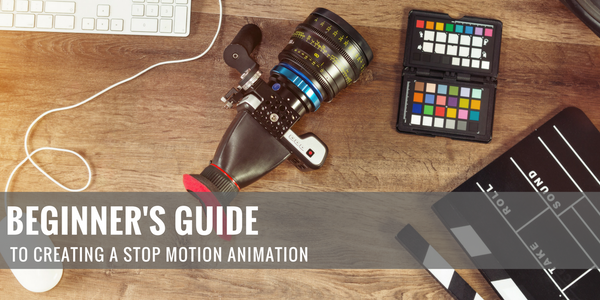Beginner's Guide to Creating a Stop Motion Animation

You may have never heard of stop motion animation, but you’ve definitely seen it in action.
Stop motion animation is a filmmaking technique that makes inanimate objects appear to move all on their own, think Wallace and Gromit or everyone’s favorite green character, Gumby.
So how do Aardman, Pixar and even 6-year-old kids do it? And how can you do it?
Needed Supplies
A creative idea — This is a movie you’re making, so you need a creative idea to turn an object and scene into something people will want to watch.
Object(s) — For beginners, it’s best to start with one object, but you can also use multiples. Common objects used in these types of animated films are clay, food, toys, LEGOs and paper.
Scene — Your scene can be as easy as your chosen object’s natural environment, a solid backdrop, like a wall or inside a photo light box, or a bunch of objects creatively thrown together to create a scene.
Camera — You can use a nice digital camera, but your smartphone or tablet work, too.
Tripod — You want each picture you take to be clearly focused on the object. Our hands naturally shake, so to ensure the best images, set your camera on a tripod.
A location that has good, consistent lighting — Natural light provided by the sun is great for taking beautiful food photos, but it’s a bad choice for stop motion animation shots. The sun moves and its movement during your photo shoot will cause unwanted random shadows. You need a location where you can control the lighting (like the SHOTBOX!).
Editing software or a stop motion animation app — You won’t be editing every photo, but you need editing software or a stop motion animation app that lets you easily edit them all together to create your mini masterpiece.
How to Do It
Now that you have your needed equipment, it’s time to walk you through the steps of creating your very own stop motion animation movie using a video editor and a computer.
Step 1: Create a storyboard.
It’s always best to go into something with a plan. Your storyboard will map out each scene for your short film, including what the objects will be doing and music or narration used, helping you see your scenes before you shoot them.
Step 2: Shoot photos of your animation.
To capture your first frame, first set up your scene, place your object(s) in front of your camera and then snap a photo. Next, ever so slightly move your object(s) within your scene and snap another photo. You then repeat this process—patience is key here—numerous times, like anywhere from 20 to 2,000, depending on how long of a movie you want to create.
Step 3: Download your photos onto your computer.
Once you’ve taken all your photos, transfer them from your camera or digital device and save them onto your computer.
Step 4: Turn your photos into an animated movie using your movie editing software.
Next, import your photos to your video editor. Then, turn them into an animated movie by choosing your ideal frame rate—varies according to software and your preference so play around to find what on-screen time length works best for you. Play around with other features you’d like to add, such as music, narration, special effects, title, etc. Finally, save your movie, watch and enjoy!
If you choose to use a stop motion animation app, you’ll shoot the photos and edit them together all from within the app on your smartphone or tablet.
Stop Motion Animation Tips
As a beginner, it’s good to learn what you should and shouldn’t do when creating a stop motion animation film. A handful of noteworthy tips include:
- Never change the exposure or focus of your camera.
- Try and shoot a scene during one session. Do your best to plan to have plenty of uninterrupted time to shoot.
- Take more photos than you think you’ll need. It’s easy to delete photos rather than trying to go back and recreate your scene to take more.
- Do your homework to find the right software.
- Shoot indoors so wind or other weather elements don’t ruin your scene or blow your objects over during shooting.